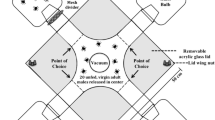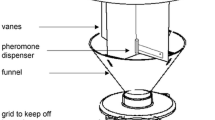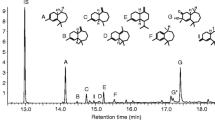Abstract
The aggregation-attachment pheromone componentso-nitrophenol (ONP) and methyl salicylate (MS) in maleAmblyomma variegatum ticks appeared after three days of feeding on the host and reached high values after about six days. Variable quantities of 1.3–7.3 μg ONP and about 0.6 μg MS were present within ticks. ONP and MS were released at the high rates of 300–1800 ng/hr and 20–600 ng/hr per male tick, respectively. After a temporary decrease, males continued to emit at high rates after nearby attachment of females. InA. hebraeum, ONP showed a similar pattern, but with a delay of about a day. A male, which had fed during 14 days, contained about 2 μg and released 225–280 ng/hr. Emission in forcibly detached males of both species dropped rapidly to low levels of less than 10 ng/hr per tick. Host skin and tick feces in the vicinity of feeding males were pheromoneimpregnated. The very high emission rates are consistent with the observations that the pheromone is an important component of the host-location mechanism of conspecifics. ONP and MS are produced in the dermal glands type 2 associated with the ventrolateral cuticle.
Similar content being viewed by others
References
Allan, S.A., Phillips, J.S., Taylor, D. andSonenshine, D.E. 1988. Genital sex pheromones of ixodid ticks: Evidence for the role of fatty acids from the anterior reproductive tract in mating ofDermacentor variabilis andDermacentor andersoni.J. Insect Physiol. 34:315–323.
Allan, S.A., Phillips, J.S., andSonenshine, D.E. 1989. Species recognition elicited by differences in composition of genital sex pheromone inDermacentor variabilis andD. andersoni (Acari: Ixodidae).J. Med. Entomol. 26:539–546.
Apps, P.J., Viljoen, H.W., andPretorius, V. 1988. Aggregation pheromones of the bont tickAmblyomma hebraeum: Identification of candidates for bioassay.Onderstepoort J. Vet. Res. 55:135–137.
Balashov, Y.S. 1972. Bloodsucking ticks (Ixodoidea)-vectors of diseases of man and animals.Misc. Publ. Entomol. Soc. Am. 8:161–376 (Translation No. 500, U.S. NAMRU-3, original Russian publication by Nauka Publishers, Leningrad, 1968).
Gladney, W.J. 1971. Mate-seeking by femaleAmblyomma maculatum Koch (Acarina: Ixodoidea) on a bovine.Nature 232:401–402.
Gladney, W.J., Ernst, S.E., andGrabbe, R.R. 1974a. The aggregation response of the Gulf coast tick on cattle.Ann. Entomol. Soc. Am. 67:750–752.
Gladney, W.J., Grabbe, R.R., Ernst, S.E., andOehler, D.D. 1974b. The Gulf coast tick: Evidence of a pheromone produced by males.J. Med. Entomol. 11:303–306.
Gödde, J. 1985. Low cost storing of two electrical biosignals from DC to 20 kHz at more than 80 dB dynamic range.Pfluegers Arch. 403:324–327.
Hamilton, J.G.C., Sonenshine, D.E., andLusby, W.R. 1989. Cholesteryl oleate: mounting sex pheromone of the hard tickDermacentor variabilis (Say) (Acari: Ixodoidea).J. Insect Physiol. 35:873–879.
Hess, E., andDe Castro, J.J. 1986. Field tests of the response of femaleAmblyomma variegatum (Acari: Ixodoidea) to the synthetic aggregation-attachment pheromone and its components.Exp. Appl. Acarol. 2:249–255.
Hoogstraal, H. 1956. African Ixodoidea. I. Ticks of the Sudan. U.S. Naval Department of Medical Zoology, 1–1101 pp.
Kellum, D., andBerger, R.S. 1977. Relationship of the occurrence and function of 2,6-dichlorophenol in two species ofAmblyomma (Acari: Ixodoidea).J. Med. Entomol. 13:701–705.
Kuwata, K., andTanaka, S. 1988. Liquid Chromatographic determination of traces of phenols in air.J. Chromatogr. 442:407–411.
Lees, A.D. 1947. Transpiration and the structure of the epicuticle in ticks.J. Exp. Biol. 23:379–410.
Norval, R.A.I., andRechav, Y. 1979. An assembly pheromone and its perception in the tickAmblyomma variegatum (Acarina, Ixodoidea).J. Med. Entomol. 16:507–511.
Norval, R.A.I., Andrew, H.R., andYunker, C.E. 1989a. Pheromone-mediation of host-selection in bont ticks (Amblyomma hebraeum Koch).Science 243:364–365.
Norval, R.A.I., Butler, J.F., andYunker, C.E. 1989b. Use of carbon dioxide and natural or synthetic aggregation-attachment pheromone of the bont tick,Amblyomma hebraeum, to attract and trap unfed adults in the field.Exp. Appl. Acarol. 7:171–180.
Rechav, Y. 1977. Evidence for an assembly pheromone(s) produced by males of the bont tickAmblyomma hebraeum (Acarina, Ixodoidea).J. Med. Entomol. 14:71–78.
Rechav, Y., Whitehead, G.B., andKnight, M.M. 1976. Aggregation response of nymphs to pheromone(s) produced by the males of the tickAmblyomma hebraeum (Koch).Nature 259:563–564.
Rechav, Y., Terry, S., Knight, M.M. andCross, R.M.M. 1977. Chemoreceptor organs used in detection of pheromone(s) of the tickAmblyomma hebraeum (Acarina, Ixodoidea).J. Med. Entomol. 14:395–400.
Schöni, R. 1987. Das wirtsgebundene Aggregationspheromon der tropischen BuntzeckeAmblyomma variegatum Fabricius (Acari: Ixodoidea). PhD thesis, University of Neuchâtel. 145 pp.
Schöni, R., Hess, E., Blum, W., andRamstein, K. 1984. The aggregation-attachement pheromone of the tropical bont tickAmblyomma variegatum Fabricius (Acari: Ixodoidea): Isolation, identification and action of its components.J. Insect Physiol. 30:613–618.
Sonenshine, D.E. 1984. Pheromones of Acari and their potential use in control strategies, pp. 100–108,in D.A. Griffiths and C.E. Bowman (eds.). Acarology VI, Vol. 1. Ellis Horwood, Chichester.
Sonenshine, D.E. 1985. Pheromones and other semiochemicals of the Acari.Annu. Rev. Entomol. 30:1–28.
Sonenshine, D.E. 1986. Tick pheromones: An overview, pp. 342–360,in J.R. Sauer and J.A. Hair (eds.). Morphology, Physiology, and Behavioral Biology of Ticks. Ellis Horwood, Chicester.
Sonenshine, D.E., Silverstein, R.M., andRechav, Y. 1982. Tick pheromone mechanisms, pp. 439–468,in F.D. Obenchain and R.L. Galun (eds.). Physiology of Ticks. Pergamon, Oxford.
Wood, W.F., Leahy, M.G., Galun, R., Prestwich, G.D., Meinwald, J., Prunell, R.E., andPayne, R.C. 1975. Phenols as pheromones of ixodid ticks: A general phenomenon?J. Chem. Ecol. 1:501–509.
Author information
Authors and Affiliations
Rights and permissions
About this article
Cite this article
Diehl, P.A., Guerin, P., Vlimant, M. et al. Biosynthesis, production site, and emission rates of aggregation-attachment pheromone in males of twoAmblyomma ticks. J Chem Ecol 17, 833–847 (1991). https://doi.org/10.1007/BF01395594
Received:
Accepted:
Issue Date:
DOI: https://doi.org/10.1007/BF01395594




